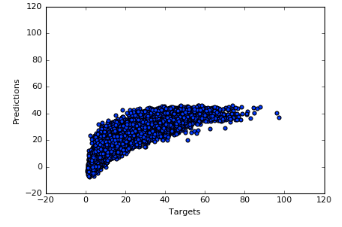I have a very simple feed-forward neural network architecture set up to perform regression on a some what nonlinear dataset i.e the mapping from inputs (47 dimensional) to output (1 dimensional real value) is non-linear.
I wanted to start small and hence am trying to fit the data using the architecture described below. I am trying to replicate the architecture described in a publication wherein the only difference is the second-order Levenberg-Marquardt optimization method. However, I am seeing that my model is unable to handle the range of the target values and is only predicting in a small range. Any help with regard to explaining the current model behavior would be greatly appreciated.
To clarify, I have also included a histogram of the target values that are used to train the model (see below). From this, I guess the way I’m reading it is that the model is overfitting to the mean value of the distribution or some small range around the mean value? I have also tried SGD, Adam and RProp all yielding similar results as observed in this case. I also tried normalizing the target values to have a range between (-1,1) and even in that case, the training data scatter plot is similar to the one below. However, IMO, since I’m using a linear layer, the scale of the data shouldn’t really affect the model much and the model should be able to learn the range of y values but I could very well be wrong / missing something.
Plot Training Predictions, Training Loss & Target Value Histogram
Model
if torch.cuda.is_available():
device = torch.device('cuda')
else:
device = torch.device('cpu')
D_in = X_train.shape[1]
D_out = 1
H = 25
NUMEPOCHS = 400
# Fully connected neural network with one hidden layer
class NeuralNet(torch.nn.Module):
def __init__(self, input_size, hidden_size, output_size):
super(NeuralNet, self).__init__()
self.fc1 = torch.nn.Linear(input_size, hidden_size)
self.tanh = torch.nn.Tanh()
self.fc2 = torch.nn.Linear(hidden_size, output_size)
def forward(self, x):
out = self.fc1(x)
out = self.tanh(out)
out = self.fc2(out)
return out
model = NeuralNet(D_in, H, D_out).to(device)
# Loss and optimizer
criterion = torch.nn.MSELoss()
optimizer = optim.RMSprop(model.parameters(), lr=0.0001)
#Input Data
trainX = Variable(torch.from_numpy(X_train).float())
trainY = Variable(torch.from_numpy(y_train).float())
valX = Variable(torch.from_numpy(X_val).float())
valY = Variable(torch.from_numpy(y_val).float())
testX = Variable(torch.from_numpy(X_test).float())
testY = Variable(torch.from_numpy(y_test).float())
losses=list()
# Train the model
data_train_loader = DataLoader(list(zip(trainX,trainY)), batch_size=1000, shuffle=True)
for epoch in range(NUMEPOCHS):
print("Epochs = {}".format(epoch))
alltargets=list()
allpredictions=list()
for batchX,batchY in data_train_loader:
# Forward pass
outputs = model(batchX)
loss = criterion(outputs, batchY)
allpredictions.append(outputs)
alltargets.append(batchY)
# Backward and optimize
optimizer.zero_grad()
loss.backward()
optimizer.step()
losses.append(loss)

